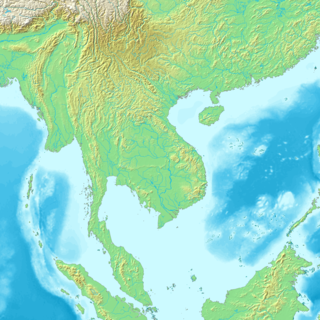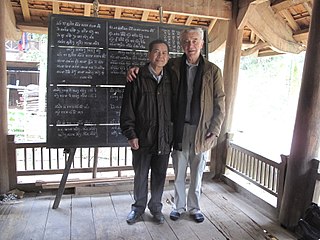Related Research Articles

Sino-Tibetan, in a few sources also known as Trans-Himalayan, is a family of more than 400 languages, second only to Indo-European in number of native speakers. The vast majority of these are the 1.3 billion native speakers of Chinese languages. Other Sino-Tibetan languages with large numbers of speakers include Burmese and the Tibetic languages. Other languages of the family are spoken in the Himalayas, the Southeast Asian Massif, and the eastern edge of the Tibetan Plateau. Most of these have small speech communities in remote mountain areas, and as such are poorly documented.

Mainland Southeast Asia is the continental portion of Southeast Asia. It lies east of the Indian subcontinent and south of China and is bordered by the Indian Ocean to the west and the Pacific Ocean to the east. It includes the countries of Cambodia, Laos, Myanmar (Burma), Peninsular Malaysia, Thailand and Vietnam.
The languages of East Asia belong to several distinct language families, with many common features attributed to interaction. In the Mainland Southeast Asia linguistic area, Chinese varieties and languages of southeast Asia share many areal features, tending to be analytic languages with similar syllable and tone structure. In the 1st millennium AD, Chinese culture came to dominate East Asia. Classical Chinese was adopted by scholars in Vietnam, Korea, and Japan. There was a massive influx of Chinese vocabulary into these and other neighboring languages. The Chinese script was also adapted to write Vietnamese, Korean, and Japanese, though in the first two the use of Chinese characters is now restricted to university learning, linguistic or historical study, artistic or decorative works and newspapers.

In anthropology and geography, a cultural region, cultural sphere, cultural area or culture area refers to a geography with one relatively homogeneous human activity or complex of activities (culture). Such activities are often associated with an ethnolinguistic group and with the territory it inhabits. Specific cultures often do not limit their geographic coverage to the borders of a nation state, or to smaller subdivisions of a state. Cultural "spheres of influence" may also overlap or form concentric structures of macrocultures encompassing smaller local cultures. Different boundaries may also be drawn depending on the particular aspect of interest, such as religion and folklore vs. dress and architecture vs. language.
In linguistics, areal features are elements shared by languages or dialects in a geographic area, particularly when such features are not descended from a proto-language, or, common ancestor language. That is, an areal feature is contrasted to genealogically determined similarity within the same language family. Features may diffuse from one dominant language to neighbouring languages.
Tani, is a branch of Sino-Tibetan languages spoken mostly in Arunachal Pradesh, India and neighboring regions.

Thai people, Central Thai or Siamese, in a narrow sense, are a Tai ethnic group dominant in Central and Southern Thailand. Part of the larger Tai ethno-linguistic group native to Southeast Asia as well as Southern China and Northeast India, Thais speak the Central Thai language, which is classified as part of the Kra–Dai family of languages. The majority of Thais are followers of Theravada Buddhism.
James Alan Matisoff is a professor emeritus of Linguistics at the University of California, Berkeley and noted authority on Tibeto-Burman languages and other languages of mainland Southeast Asia.

The East Asian cultural sphere, Chinese cultural sphere or Sinosphere encompasses the countries within East and Southeast Asia that were historically influenced by Chinese culture. The region is not to be confused with Greater China, a region that encompasses countries with majority Han Chinese or Chinese-speaking populations.
Indosphere is a term coined by the linguist James Matisoff for areas of Indian linguistic and cultural influence in Southeast Asia. It is commonly used in areal linguistics in contrast with Sinosphere.

The Karen or Karenic languages are tonal languages spoken by some seven million Karen people. They are of unclear affiliation within the Sino-Tibetan languages. The Karen languages are written using the Burmese script. The three main branches are Sgaw, Pwo and Pa'o. Karenni and Kayan are related to the Sgaw branch. They are unusual among the Sino-Tibetan languages in having a subject–verb–object word order; other than Karen, Bai and the Chinese languages, Sino-Tibetan languages have a subject–object–verb order. This is likely due to influence from neighboring Mon and Tai languages.

Thailand is home to 71 living languages, with the majority of people speaking languages of the Southwestern Tai family, and the national language being Thai. Lao is spoken along the borders with the Laos PDR, Karen languages are spoken along the border with Myanmar, Khmer is spoken near Cambodia and Malay is spoken in the south near Malaysia. Sixty-two 'domestic' languages are officially recognized, and international languages spoken in Thailand, primarily by international workers, expatriates and business people, include Burmese, Karen, English, Chinese, Japanese, and Vietnamese, among others.

East Asia is the eastern region of Asia, which is defined in both geographical and ethno-cultural terms. The modern states of East Asia include China, Hong Kong, Japan, Macau, Mongolia, North Korea, South Korea and Taiwan. The East Asian states of China, North Korea, South Korea and Taiwan are all unrecognized by at least one other East Asian state due to severe ongoing political tensions in the region, specifically the division of Korea and the political status of Taiwan. Hong Kong and Macau, two small coastal quasi-dependent territories located in the south of China, are officially highly autonomous but are under de jure Chinese sovereignty. North Asia borders East Asia's north, Southeast Asia the south, South Asia the southwest and Central Asia the west. To the east is the Pacific Ocean and to the southeast is Micronesia. Singapore and Vietnam are also considered a part of the East Asian cultural sphere due to its cultural, religious, and ethnic similarities. Singapore was also one of the Four Asian Tigers.
Primarily in Austroasiatic languages, in a typical word a minor syllable is a reduced (minor) syllable followed by a full tonic or stressed syllable. The minor syllable may be of the form or, with a reduced vowel, as in colloquial Khmer, or of the form with no vowel at all, as in Mlabri "navel" and "underneath", and Khasi kyndon "rule", syrwet "sign", kylla "transform", symboh "seed" and tyngkai "conserve". This iambic pattern is sometimes called sesquisyllabic, a term coined by the American linguist James Matisoff in 1973.
Proto-Tibeto-Burman (PTB) is the reconstructed ancestor of the Tibeto-Burman languages, that is, the Sino-Tibetan languages except for Chinese. An initial reconstruction was produced by Paul K. Benedict and since refined by James Matisoff. Several other researchers argue that the Tibeto-Burman languages sans Chinese do not constitute a monophyletic group within Sino-Tibetan, and therefore that Proto-Tibeto-Burman was the same language as Proto-Sino-Tibetan.

The Mainland Southeast Asia linguistic area is a sprachbund including languages of the Sino-Tibetan, Hmong–Mien, Kra–Dai, Austronesian and Austroasiatic families spoken in an area stretching from Thailand to China. Neighbouring languages across these families, though presumed unrelated, often have similar typological features, which are believed to have spread by diffusion. James Matisoff referred to this area as the "Sinosphere", contrasted with the "Indosphere", but viewed it as a zone of mutual influence in the ancient period.

Michel Ferlus is a French linguist whose special study is in the historical phonology of languages of Southeast Asia. In addition to phonological systems, he also studies writing systems, in particular the evolution of Indic scripts in Southeast Asia.
Sinosphere traditionally refers to the East Asian cultural sphere, nations that have historically been influenced by China in terms of literary traditions, culture and religions.
The East Asian languages are a language family proposed by Stanley Starosta in 2001. The proposal has since been adopted by George van Driem.
The Proto-Karenic or Proto-Karen language is the reconstructed ancestor of the Karenic languages.
References
- ↑ Matisoff, James A. (1990). On Megalocomparison. Language 66.1, p. 113.
- ↑ N.J. Areal Linguistics and Mainland Southeast Asia, Annual Review of Anthropology 2005. 34:181–206